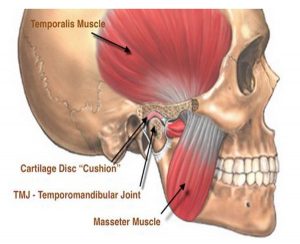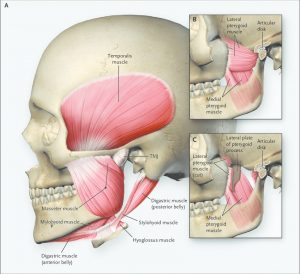TMJ actually means “Temporomandibular Joint”. It is where the Mandible articulates with the skull. The TM joint is separated by a cartilage Disc or “cushion” that allows translation of the joint without grinding of the bones. It is a very specialized and complex joint. It allows for movements like that of a hinge joint or ball and socket joint, allowing for open closing protraction and retraction, and also side to side movements. Though we say TMJ, we actually mean TMD, or TMJD.
SO JUST WHAT IS TMD OR TMJD? (WHY SO MANY ACRONYMS?!?!)
TMD stands for Temporomandibular joint disorder (TMJD), or just Temporomandibular Disorder (TMD). This is an umbrella term for injuries, or an injurious response, when the joint itself is irritated and or has received damage or trauma. They say that only 15% of adults suffer from TMJ disorders and or problems. Of that 15% most sufferers are female.
- ISSUES OR INJURIES THAT ARE RELATED TO TMD COULD BE:
- Malocclusion of teeth. Definition: The teeth are not aligned properly.
- Micrognathia. Definition: The lower jaw is smaller than normal.
- Osteonecrosis of the jaw. Definition: A rare condition involving loss, or breakdown of a small segment of the jaw bone.
- Mixed Dentition. Definition: The teeth in the jaw are adjusted after the eruption of some of the permanent teeth, but before all the baby teeth are exfoliated. (This can be a reason why some children Brux, or grind their teeth at night)
- Injuries: Car accidents, trauma to the face, prolonged opening of the jaw, facial surgeries, and sports related injuries, are just some of the types of injuries that can help cause TMD.
- Stress and anxiety. When humans are stressed and or anxious, they tend to clench their teeth. It has been documented that folks that are stressed or anxious may grind and clench through the night. Clenching is a natural guarding mechanism for humans. Boxers are taught to clench their teeth before they get sucker-punched in the face. Surgeons, back in the day, would give their patient a wooden dowel to bite down on to help “with the pain” before doing something that would cause an extreme amount of pain, midwives would do the same thing for mothers giving birth. During the paleo era, it is known that we would clench our teeth and growl at other cave people passing by to let them know not to mess with their cave-home…ok, maybe not, but you get the picture. Whether it is stress, anxiety, depression, PTSD, pain from anywhere else, or a slew of other problems that affect us mentally, clenching and grinding can be a side effect, or even exacerbate these issues.
“YOU ARE A PAIN IN MY NECK”!!!
Some Symptoms of TMD include:
- Shoulder pain and or back pain
- Neck pain and stiffness
- Pain in or around the temple
- Headaches (Can cause headaches to be anywhere…typically in the head or down the neck)
- Pain or tenderness in the temporomandibular joint area (jaw joint)
- Limited movement and opening of the jaw: lock jaw
- Ear aches, which can be severe
- Ringing of the ears or tinnitus
- Dizziness or vertigo
- Clicking sound or popping of the jaw
ANATOMY OF THE JAW
A human jaw, while healthy and with healthy teeth, can exert over 275 pounds of pressure in a single bite. Next time the jerk in front of you cuts you off in traffic, pay attention to the muscles in your face. If you are clenching, you can exert over 200 pounds of pressure on the muscles of your jaw. Thus, effecting your neck and shoulders as well. If you do this for a long period of time, and some may not even notice they are doing it, clenching can cause or exacerbate tightness and pain in the muscles of the jaw, neck, and shoulders. Parents, next time you hold back on telling your children how you really feel, be aware of your jaw. Are your teeth touching? Parents, specifically mothers, have been known to show more tightness and tenderness in the muscles of the jaw than other clients that I have seen at Physical Therapy Connections.
What can you do to alleviate TMD issues?
- Lifestyle and home issues
- Becoming more aware of tension-related habits — clenching your jaw, grinding your teeth or chewing pencils — will help you reduce their frequency. The following tips may help you reduce symptoms of TMJ disorders:
- Avoid overuse of jaw muscle Eat soft foods. Cut food into small pieces. Steer clear of sticky or chewy food. Avoid chewing gum. Stretching and massage. Your doctor, dentist or physical therapist may show you how to do exercises that stretch and strengthen your jaw muscles and how to massage the muscles yourself. Heat or cold. Applying warm, moist heat or ice to the side of your face may help alleviate pain.
- Nondrug therapies for TMJ disorders
- Oral splints or mouth guards (occlusal appliances). Often, people with jaw pain will benefit from wearing a soft or firm device inserted over their teeth, but the reasons why these devices are beneficial are not well-understood
- Physical therapy. Along with exercises to stretch and strengthen jaw muscles, treatments might include ultrasound, moist heat and ice
- Counseling. Education and counseling can help you understand the factors and behaviors that may aggravate your pain, so you can avoid them. Examples include teeth clenching or grinding, leaning on your chin, or biting fingernails
- Alternative Medicine – Complementary and alternative medicine techniques may help manage the chronic pain often associated with TMJ disorders. Examples include:
- Massage Therapy. Receiving massage to the muscles that are affected by TMD, may help relieve pain and tightness to the muscles of the face, neck, shoulders and back.
- If there is a structural deviation in the jaw or neck, a DC may be able help alleviate pain in the areas of the jaw, neck, shoulders, and back.
- Acupuncture. A specialist trained in acupuncture treats chronic pain by inserting hair-thin needles at specific locations on your body.
- Relaxation techniques. Consciously slowing your breathing and taking deep, regular breaths can help relax tense muscles, which can reduce pain.
- Biofeedback. Electronic devices that monitor the tightness of specific muscles can help you practice effective relaxation techniques.
If that doesn’t work…
- Medications
Along with other nonsurgical treatments, these medication options may help relieve the pain associated with TMJ disorders
- Pain relievers and anti-inflammatories. If over-the-counter pain medications aren’t enough to relieve TMJ pain, your doctor or dentist may prescribe stronger pain relievers for a limited time, such as prescription strength ibuprofen
- Tricyclic antidepressants. These medications, such as amitriptyline, are used mostly for depression, but in low doses, they’re sometimes used for pain relief, bruxism control and sleeplessness
- Muscle relaxants. These types of drugs are sometimes used for a few days or weeks to help relieve pain caused by TMJ disorders created by muscle spasms
- Surgical or other procedures
When other methods don’t help, your doctor might suggest procedures such as:
- Arthrocentesis. Arthrocentesis (ahr-throe-sen-TEE-sis) is a minimally invasive procedure that involves the insertion of small needles into the joint so that fluid can be irrigated through the joint to remove debris and inflammatory byproducts
- Injections. In some people, corticosteroid injections into the joint may be helpful. Infrequently, injecting botulinum toxin type A (Botox, others) into the jaw muscles used for chewing may relieve pain associated with TMJ disorders
- TMJ arthroscopy. In some cases, arthroscopic surgery can be as effective for treating various types of TMJ disorders as open-joint surgery. A small thin tube (cannula) is placed into the joint space, an arthroscope is then inserted and small surgical instruments are used for surgery. TMJ arthroscopy has fewer risks and complications than open-joint surgery does, but it has some limitations as well
- Modified condylotomy. Modified condylotomy (kon-dih-LOT-uh-mee) addresses the TMJ indirectly, with surgery on the mandible, but not in the joint itself. It may be helpful for treatment of pain and if locking is experienced
- Open-joint surgery. If your jaw pain does not resolve with more-conservative treatments and it appears to be caused by a structural problem in the joint, your doctor or dentist may suggest open-joint surgery (arthrotomy) to repair or replace the joint. However, open-joint surgery involves more risks than other procedures do and should be considered very carefully, after discussing the pros and cons. If your doctor recommends surgery or other procedures, be sure to discuss the potential benefits and risks, and ask what all your options are.
PLEASE JOIN US MARCH 22, @ 6:00 pm FOR A FREE SEMINAR ON TMD, AND LEARN SOME THINGS YOU CAN DO AT HOME TO HELP YOURSELF! Prizes and goodies will be provided 🙂
CLICK HERE TO RSVP YOUR SPOT!
*The first person to RSVP and show up will receive a free half hour massage!*


